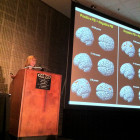
Focus on: Adolescent Brain Development
|
Explore JJIE’s coverage of adolescent brain development and how it relates to youth system involvement, substance use and families and communities.
Juvenile Justice Information Exchange (https://jjie.org/tag/evidence-based-latest/page/2/)

Explore JJIE’s coverage of adolescent brain development and how it relates to youth system involvement, substance use and families and communities.

The ultimate goal is to provide youth and families in high-need communities with a comprehensive community network of supports.

The man who took the fight against life without parole sentences for juveniles to the U.S. Supreme Court said he is optimistic about juvenile justice trends, but said there is much work to do in a few areas, most especially around housing youth in adult lockups.

Is the Illinois DJJ providing adequate & required mental health and education services? Some are saying no.

Leaders and experts explore using brain science to craft new juvenile justice policies at a forum at the National Conference of State Legislatures.

COVINGTON, Ga. -- This small community to the east of Atlanta isn’t necessarily the kind of locale one would associate with progressive juvenile justice policies. Yet here, deep in the rustic Georgian countryside, the local juvenile court has embraced an innovative model where keeping kids out of trouble, the courtroom and especially detention has become an utmost priority.

A recent JJIE article titled "In Georgia, Sex Abuse Allegations Cloud Progress of Juvenile Justice Reform" is a story of contradictions -- in the midst of juvenile justice reform comes the federal report showing that Georgia has among the nation’s highest rates of sexual assaults in its secure juvenile facilities. The Atlanta Journal Constitution quoted my response -- "distressing." Although "distressing," these allegations do not "cloud" the progress of juvenile justice reform -- they underscore the reasons for reform. These stories aptly report "what" and provide some insight into "why" this distressing problem is occurring, but there is much more to the "why.” There is an elephant in the room -- the misuse and overuse of secure detention facilities. George Bernard Shaw wrote that "All great truths begin as blasphemies," and so, this is my blasphemy: We are making communities less safe by sending too many of the wrong kids to youth prison that turns them from the aggravating sort into the scary sort.

The funding is intended to provide three of the state’s judicial districts with resources to evaluate and improve youth services and juvenile programs.

In a pair of feature stories published yesterday, (on Georgia's reform efforts and issues and two young men in the system) JJIE described two modes of intensive at-home treatment that show great promise to improve outcomes for emotionally disturbed youth in the delinquency system, both of which cost far less than incarceration or treatment in a residential treatment center.

If it's possible for a public policy research topic to be "in vogue," juvenile justice has been a craze for the past decade. Bookshelves and flash drives have been filled with statistics and studies of crimes by kids and against kids and what approaches are best at preventing and responding to both. The evidence-based practices evolving from this research have helped reduce crime and the number of incarcerated children in America. The bumper crop of research is due in large part to the confluence of tight state budgets and the commitment of the MacArthur Foundation and several other foundations, which have insisted on the collection of data and analysis -- the evidence of best practices. [Editor’s note: The MacArthur Foundation is a funder of the JJIE.] The latest harvest in that bumper crop has grabbed the attention of policy wonks and could result in even more use of preventative practices that keep kids out of prison cells and deliver successful and less expensive responses at the community level.